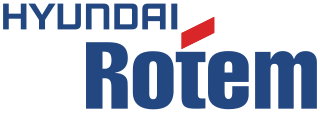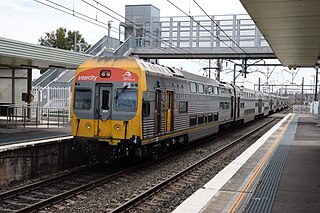
CityRail was an Australian passenger train operator with services in and around Sydney, Newcastle and Wollongong, the three largest cities in New South Wales as well as some rail replacement bus services. It was established in January 1989 and abolished in June 2013 when it was superseded by Sydney Trains and NSW TrainLink.

The Sydney Trains M sets or Millennium trains are a class of electric multiple unit operated by Sydney Trains in Sydney, New South Wales, Australia. The fourth generation trains entered service from 1 July 2002 after short delays due to electrical defects. The trains can operate over the entire suburban network, but currently only operate on T2 Inner West & Leppington, T3 Bankstown, T5 Cumberland, T6 Carlingford, T7 Olympic Park and T8 Airport & South lines.

The Tangara is a class of electric multiple unit operated by Sydney Trains in Sydney, Australia. The Tangaras were delivered between 1988 and 1995, and are third-generation trains.

Hyundai Rotem is a South Korean company manufacturing rolling stock, defense products and plant equipment. It is part of the Hyundai Motor Group. Its name was changed to the current one from Rotem in December 2007 to reflect its parent company.

The Central Coast & Newcastle Line is a NSW TrainLink passenger train service that runs along the Main North railway line in New South Wales, connecting the state's two largest cities, Sydney and Newcastle. The service runs from Central through to Broadmeadow on the Main North railway line to Newcastle Interchange on the Newcastle railway line, and services the Hawkesbury River region, the Central Coast and the city of Newcastle.

The Blue Mountains Line is an intercity rail service operated by NSW TrainLink serving the Blue Mountains region of New South Wales, Australia. The line travels west from Sydney to the major town of Katoomba and on to Lithgow on the western foothills of the mountains. 2 Express services per day in each direction, known as the Bathurst Bullet, extend to the regional city of Bathurst, which is supplemented by road coaches connecting Bathurst to Lithgow. The Blue Mountains Line operates over a mostly duplicated section of the Main Western line. As such, the tracks are also traversed by the Central West XPT, Outback Xplorer and Indian Pacific passenger services and by freight trains.
UGL Rail is an Australian rail company specialising in building, maintaining and refurbishing diesel locomotives, diesel & electric multiple units and freight wagons. It is a subsidiary of UGL Limited and is based in Melbourne, with a staff of 1,200 across Australia and Asia. It operates factories in Broadmeadow, Maintrain Auburn, Spotswood and Bassendean. While it used to operate a factory in Taree, the plant has currently shut down and the equipment sold off.
The Sydney Trains fleet serves the metropolitan lines within Sydney, Australia. All of the rolling stock are double-deck electric multiple units and operate mainly as eight carriage sets.

The NSW TrainLink H set, or OSCAR, is a class of electric multiple unit built by UGL Rail, Broadmeadow for NSW TrainLink in New South Wales, Australia. They are operated by NSW TrainLink. These sets operate services from Sydney to Newcastle, Kiama and Springwood. The first entered service in December 2006 and the last in December 2012. They are formed into 55 four-carriage sets.
The railways of New South Wales, Australia, use a large variety of passenger and freight rolling stock.

The Sydney Trains A & B sets, both also known as Waratah, are classes of electric multiple unit trains operated by Sydney Trains in Sydney, New South Wales, Australia. The trains were named Waratah by the New South Wales Government after the flower of the same name, which is the state's floral emblem.

Tulloch Limited was an Australian engineering and railway rolling stock manufacturer, located at Rhodes, New South Wales.

NSW TrainLink is an Australian coach and train operator providing services throughout New South Wales and into the neighbouring states and territories of Victoria, Queensland, South Australia and the Australian Capital Territory. It is an agency of Transport for NSW.

Sydney Trains is the suburban passenger rail network serving the city of Sydney, New South Wales, Australia. The network is a hybrid suburban-commuter rail system with a central underground core that covers over 813 km (505 mi) of track and 175 stations over nine lines. It has metro-equivalent train frequencies of every three minutes or better in the underground core, 5–10 minutes off-peak at most major stations and 15 minutes off-peak at most minor stations. During weekday peak services trains are more frequent, while frequency decreases on weekends.
Chullora Railway Workshops were a major workshops for the repair and heavy maintenance of locomotives and rolling stock for the New South Wales Government Railways.
The NSW TrainLink fleet of trains serves the areas outside Sydney, Australia, mainly interurban and interstate lines. The NSW TrainLink fleet consists of both diesel and electric traction, with the oldest of the fleet being the V sets and the youngest being the H sets.

The New South Wales Standard suburban carriage stock are a type of electric multiple unit that was operated by the New South Wales Government Railways and its successors between 1926 and 1992. They served on the Sydney suburban network. In the years before their withdrawal, they were nicknamed Red Rattlers.

The High Capacity Metro Trains are a fleet of electric multiple unit (EMU) trains on order for use by Metro Trains Melbourne on the Melbourne rail network. They are due to enter service in mid-2020 and will eventually become the primary rollingstock used in the Metro Rail Tunnel when it opens in 2025. The HCMTs will carry around 1400 passengers in 7 carriages, running on Melbourne's 1500 V DC overhead catenary system, and will be the most advanced trains in the Metro Trains fleet when they are introduced. A consortium of investors and rail companies is constructing the trains in China and Australia via a contract with the Victorian Government, in addition to upgrade works necessary for the operation of the trains.

Newcastle Transport is a transport company in Newcastle, New South Wales, working under Transport for NSW. It commenced operating the bus and ferry services formerly operated by Newcastle Buses & Ferries on 1 July 2017 under a ten-year contract. It also commenced operating the Newcastle Light Rail when it opened in February 2019. Train services are operated by sister company NSW TrainLink which is likewise a subsidiary of Transport for NSW.
The NSW TrainLink Regional Train Project is an initiative of Transport for NSW to procure new trains to replace NSW TrainLink's Endeavour, Xplorer and XPT fleets.














